Old Parasitoids for New Mealybugs: Host Location Behavior and Parasitization Efficacy of Anagyrus vladimiri on Pseudococcus comstocki
Abstract
Simple Summary
Abstract
1. Introduction
2. Materials and Methods
2.1. Insect Rearing and General Observations
2.2. Oviposition Behavior, Host Preferences, Host Suitability and Quality of the Parasitoid Progeny
2.2.1. No-Choice Tests
2.2.2. Two-Choice Tests
2.3. Statistical Analysis
3. Results
3.1. No-Choice Tests
3.2. Two-Choice Tests
4. Discussion
5. Conclusions
Author Contributions
Funding
Institutional Review Board Statement
Data Availability Statement
Acknowledgments
Conflicts of Interest
References
- Wan, H.H.; Song, B.Z.; Tang, G.B.; Zhang, J.; Yao, Y.C. What are the effects of aromatic plants and meteorological factors on Pseudococcus comstocki and its predators in pear orchards? Agrofor. Syst. 2015, 89, 537–547. [Google Scholar] [CrossRef]
- Pellizzari, G.; Duso, C.; Rainato, A.; Pozzebon, A.; Zanini, G. Phenology, ethology and distribution of Pseudococcus comstocki, an invasive pest in northeastern Italy. Bull. Insect. 2012, 65, 209–215. [Google Scholar]
- Mazzeo, G.; Longo, S.; Pellizzari, G.; Porcelli, F.; Suma, P.; Russo, A. Exotic scale insects (Coccoidea) on ornamental plants in Italy: A never-ending story. Acta Zool. Bulg. 2014, 6, 55–61. [Google Scholar]
- Guerrieri, E.; Pellizzari, G. Parasitoids of Pseudococcus Comstocki in Italy Clausenia purpurea and Chrysoplatycerus splendens First Records from Europe. Bull. Insect. 2009, 62, 179–182. [Google Scholar]
- Negishi, T.; Ishiwatari, T.; Asano, S. Sex pheromone of the Comstock mealybug, Pseudococcus comstocki Kuwana; bioassay method, male response-habits to the sex pheromone. Jpn. J. Appl. Entomol. Zool. 1980, 24, 1–5. [Google Scholar] [CrossRef][Green Version]
- Sawamura, N.; Narai, Y. Effect of temperature on development and reproductive potential of two mealybug species Planococcus kraunhiae (Kuwana) and Pseudococcus comstocki (Kuwana) (Homoptera: Pseudococcidae). Jpn. J. Appl. Entomol. Zool. 2008. [Google Scholar] [CrossRef][Green Version]
- Xu, P.; Xu, Z.; Li, S.; Xu, W.; Li, H.; Sheng, X.; Jin, W.; Wang, Y.; Zhao, Y. Life table of the experimental population of Comstock mealybug, Pseudococcus comstocki (Hemiptera: Pseudococcidae), at different temperatures. Acta Entomol. Sin. 2012, 55, 1362–1367. [Google Scholar]
- Jeon, H.Y.; Kim, D.S.; Cho, M.R.; Chang, Y.D.; Yiem, M.S. Temperature-dependent Development of Pseudococcus comstocki. Korean J. Appl. Entomol. 2004, 42, 43–51. [Google Scholar]
- Kairo, M.T.K.; Paraiso, O.; Gautam, R.D.; Peterkin, D.D. Cryptolaemus montrouzieri (Mulsant) (Coccinellidae: Scymninae): A review of biology, ecology, and use in biological control with particular reference to potential impact on non-target organisms. CAB Rev. 2013, 8, 1–20. [Google Scholar] [CrossRef]
- Malausa, T.; Delaunay, M.; Fleisch, A.; Groussier-Bout, G.; Warot, S.; Crochard, D.; Guerrieri, E.; Delvare, G.; Pellizzari, G.; Kaydan, M.B. Investigating biological control agents for controlling invasive populations of the mealybug Pseudococcus comstocki in France. PLoS ONE 2016, 11, e0157965. [Google Scholar] [CrossRef]
- Andreason, S.A.; Triapitsyn, S.V.; Perring, T.M. Untangling the Anagyrus pseudococci species complex (Hymenoptera: Encyrtidae), parasitoids of worldwide importance for biological control of mealybugs (Hemiptera: Pseudococcidae): Genetic data corroborates separation of two new, previously misidentified species. Biol. Control 2019, 129, 65–82. [Google Scholar]
- Lucchi, A.; Benelli, G. Towards pesticide-free farming? Sharing needs and knowledge promotes Integrated Pest Management. Environ. Sci. Pollut. Res. 2018, 25, 13439–13445. [Google Scholar] [CrossRef]
- Van Driesche, R.G.; Bellotti, A.; Herrera, C.J.; Castillo, J.A. Host preferences of two encyrtid parasitoids for the Columbian Phenacoccus spp. of cassava mealybugs. Entomol. Exp. Appl. 1987, 43, 261–266. [Google Scholar] [CrossRef]
- Romano, D.; Stefanini, C.; Canale, A.; Benelli, G. Artificial blood feeders for mosquito and ticks—Where from, where to? Acta Trop. 2018, 183, 43–56. [Google Scholar] [CrossRef] [PubMed]
- Islam, K.S.; Copland, M.J.W. Host preference and progeny sex ratio in a solitary koinobiont mealybug endoparasitoid, Anagyrus pseudococci (Girault), in response to its host stage. Biocontrol Sci. Technol. 1997, 7, 449–456. [Google Scholar] [CrossRef]
- Chong, J.-H.; Oetting, R.D. Specificity of Anagyrus sp. nov. nr. sinope and Leptomastix dactylopii for six mealybug species. BioControl 2007, 52, 289–308. [Google Scholar] [CrossRef]
- Romano, D.; Kavallieratos, N.G.; Athanassiou, C.G.; Stefanini, C.; Canale, A.; Benelli, G. Impact of geographical origin and rearing medium on mating success and lateralization in the rice weevil, Sitophilus oryzae (L.) (Coleoptera: Curculionidae). J. Stored Prod. Res. 2016, 69, 106–112. [Google Scholar] [CrossRef]
- Bokononganta, A.H.; Neuenschwander, P.; Vanalphen, J.J.M.; Vos, M. Host stage selection and sex allocation by Anagyrus mangicola (Hymenoptera: Encyrtidae), a parasitoid of the mango mealybug, Rastrococcus invadens (Homoptera: Pseudococcidae). Biol. Control 1995, 5, 479–486. [Google Scholar] [CrossRef]
- Sagarra, L.A.; Vincent, C.; Stewart, R.K. Suitability of nine mealybug species (Homoptera: Pseudococcidae) as hosts for the parasitoid Anagyrus kamali (Hymenoptera: Encyrtidae). Fla. Entomol. 2001, 84, 112–116. [Google Scholar] [CrossRef]
- Benelli, G.; Desneux, N.; Romano, D.; Conte, G.; Messing, R.H.; Canale, A. Contest experience enhances aggressive behaviour in a fly: When losers learn to win. Sci. Rep. 2015, 5, 9347. [Google Scholar] [CrossRef]
- Benelli, G.; Romano, D.; Desneux, N.; Messing, R.H.; Canale, A. Sex differences in fighting-induced hyperaggression in a fly. Anim. Behav. 2015, 104, 165–174. [Google Scholar] [CrossRef]
- Sokal, R.R. Single classification analysis of variance. In Biometry: The Principles and Practice of Statistics in Biological Research, 1st ed.; Rolfes, M., Ed.; W.H. Freeman and Company: New York, NY, USA, 1981; pp. 207–246. [Google Scholar]
- Cocco, A.; da Silva, V.C.P.; Benelli, G.; Botton, M.; Lucchi, A.; Lentini, A. Sustainable management of the vine mealybug in organic vineyards. J. Pest Sci. 2021, 94, 153–185. [Google Scholar] [CrossRef]
- Gullan, P.J.; Kosztarab, M. Adaptations in scale insects. Annu. Rev. Entomol. 1997, 42, 23–50. [Google Scholar] [CrossRef]
- Duso, C. Bioecological study on Planococcus ficus (Sign.) in Veneto. Boll. Lab. Entomol. Agrar. Silvestri’ 1989, 46, 3–20. [Google Scholar]
- Sagarra, L.A.; Vincent, C. Influence of Host Stage on Oviposition, Development, Sex Ratio, and Survival of Anagyrus kamali Moursi (Hymenoptera: Encyrtidae), a Parasitoid of the Hibiscus Mealybug, Maconellicoccus hirsutus Green (Homoptera: Pseudococcidae). Biol. Control 1999, 15, 51–56. [Google Scholar] [CrossRef]
- Zhang, J.; Huang, J.; Lu, Y.; Xia, T. Effects of temperature and host stage on the parasitization rate and offspring sex ratio of Aenasius bambawalei Hayat in Phenacoccus solenopsis Tinsley. PeerJ 2016, 4, e1586. [Google Scholar] [CrossRef] [PubMed]
- Messing, R.H.; Wright, M.G. Biological control of invasive species: Solution or pollution? Front. Ecol. Environ. 2006, 4, 132–140. [Google Scholar] [CrossRef]
- Parry, D. Beyond Pandora’s box: Quantitatively evaluating non-target effects of parasitoids in classical biological control. In Ecological Impacts of Non-Native Invertebrates and Fungi on Terrestrial Ecosystems; Springer: Berlin/Heidelberg, Germany, 2008; pp. 47–58. [Google Scholar]
- Bugila, A.A.A.; Franco, J.C.; da Silva, E.B.; Branco, M. Suitability of five mealybug species (Hemiptera, Pseudococcidae) as hosts for the solitary parasitoid Anagyrus sp. nr. pseudococci (Girault) (Hymenoptera: Encyrtidae). Biocontrol Sci. Technol. 2015, 25, 108–120. [Google Scholar] [CrossRef]
- Bugila, A.A.A.; Branco, M.; da Silva, E.B.; Franco, J.C. Host selection behaviour and specificity of the solitary parasitoid of mealybugs Anagyrus sp. nr. pseudococci (Girault) (Hymenoptera, Encyrtidae). Biocontrol Sci. Technol. 2014, 24, 22–38. [Google Scholar] [CrossRef]
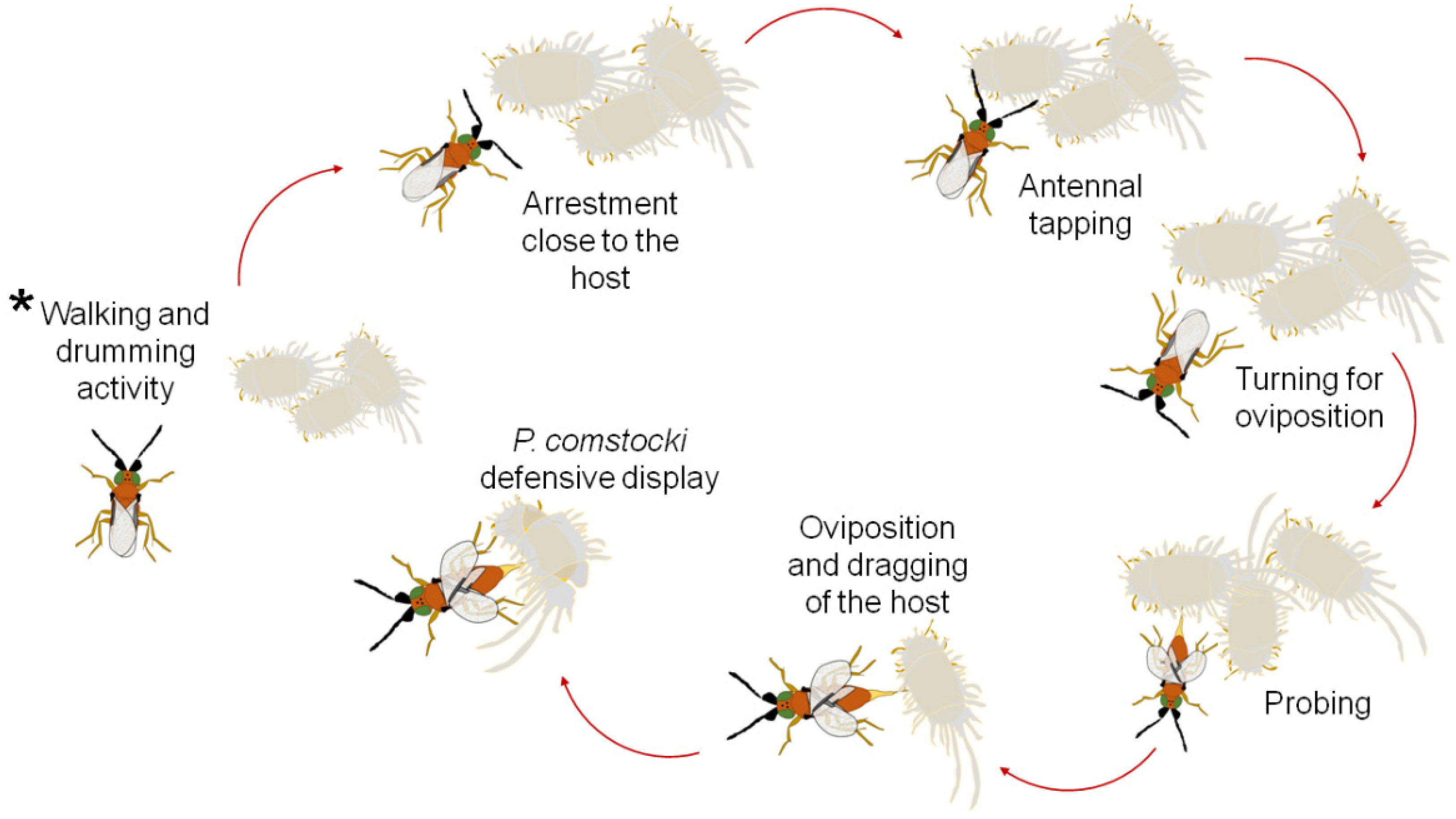
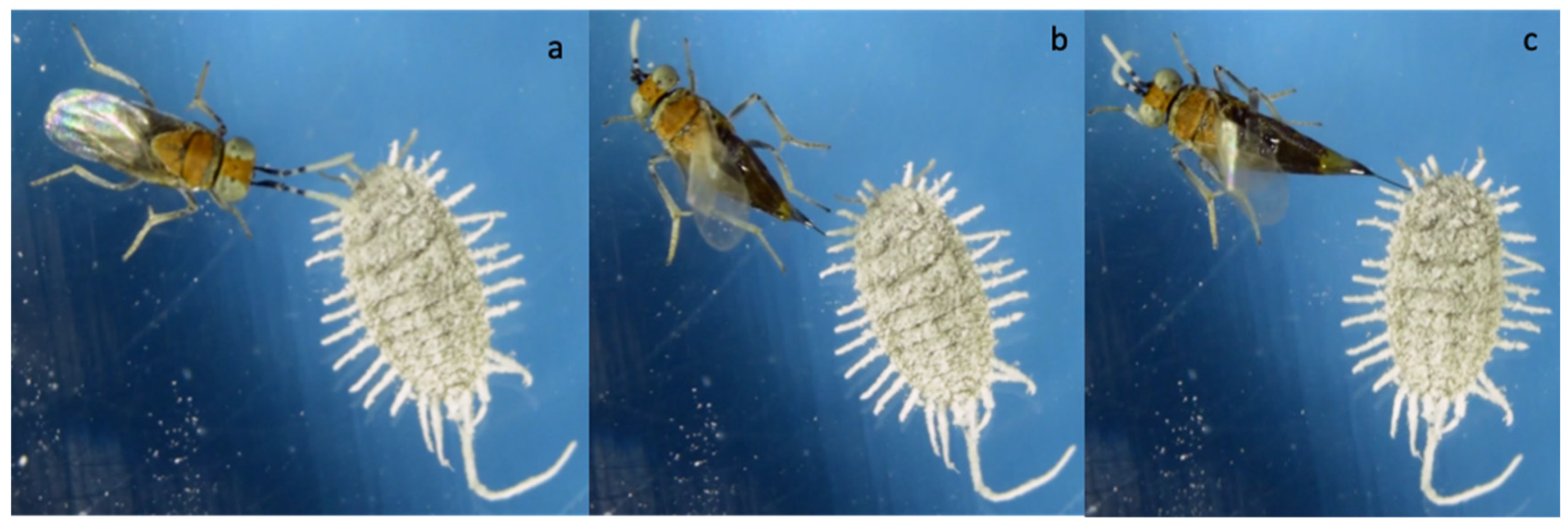



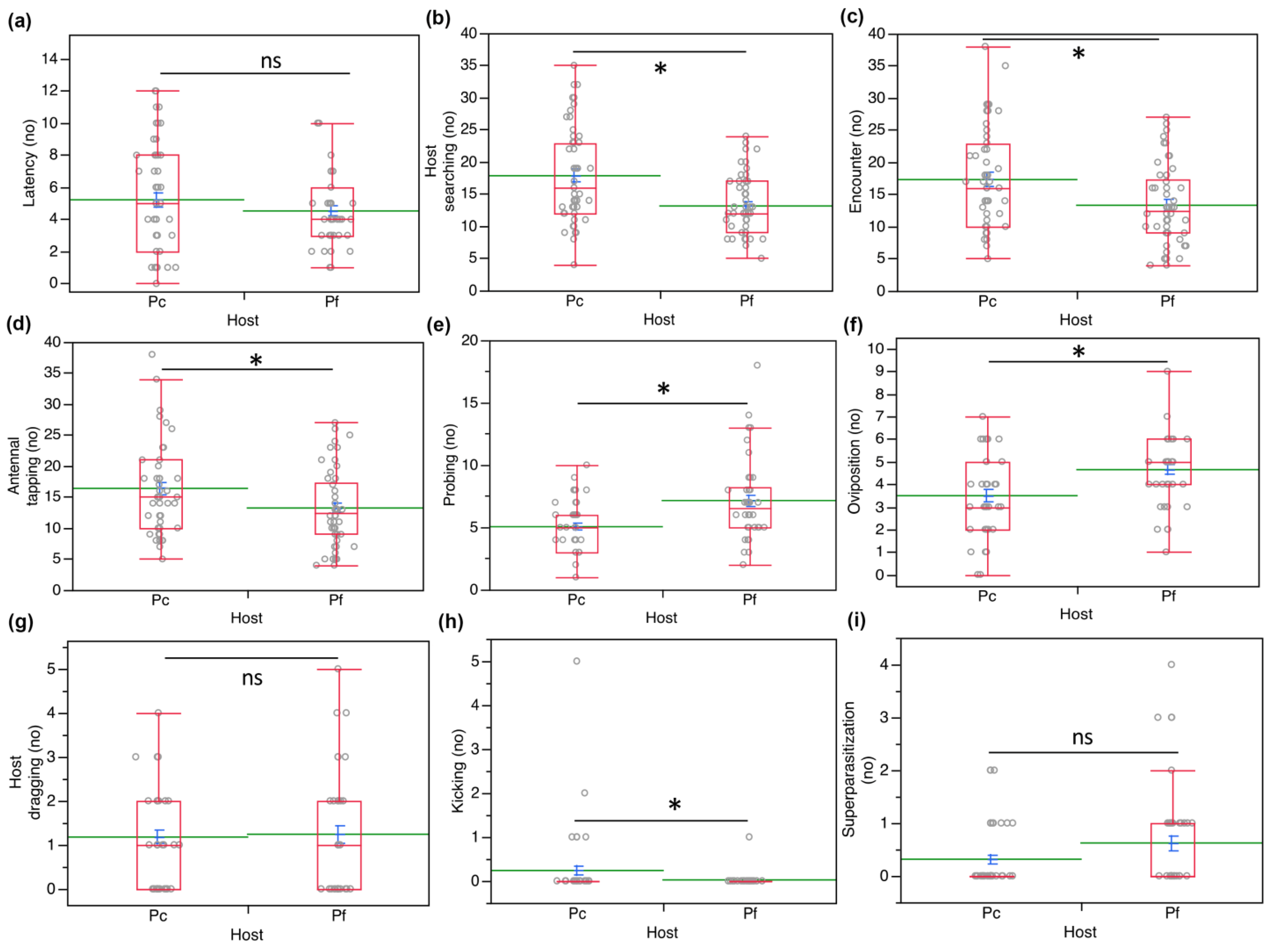
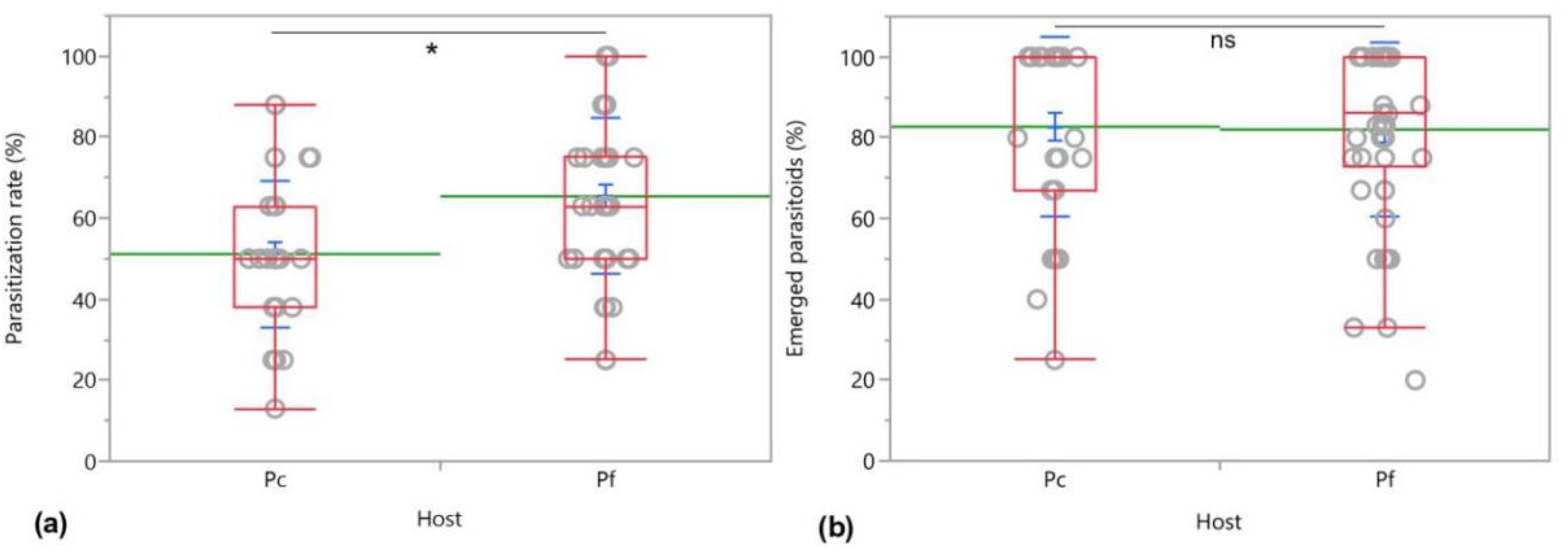
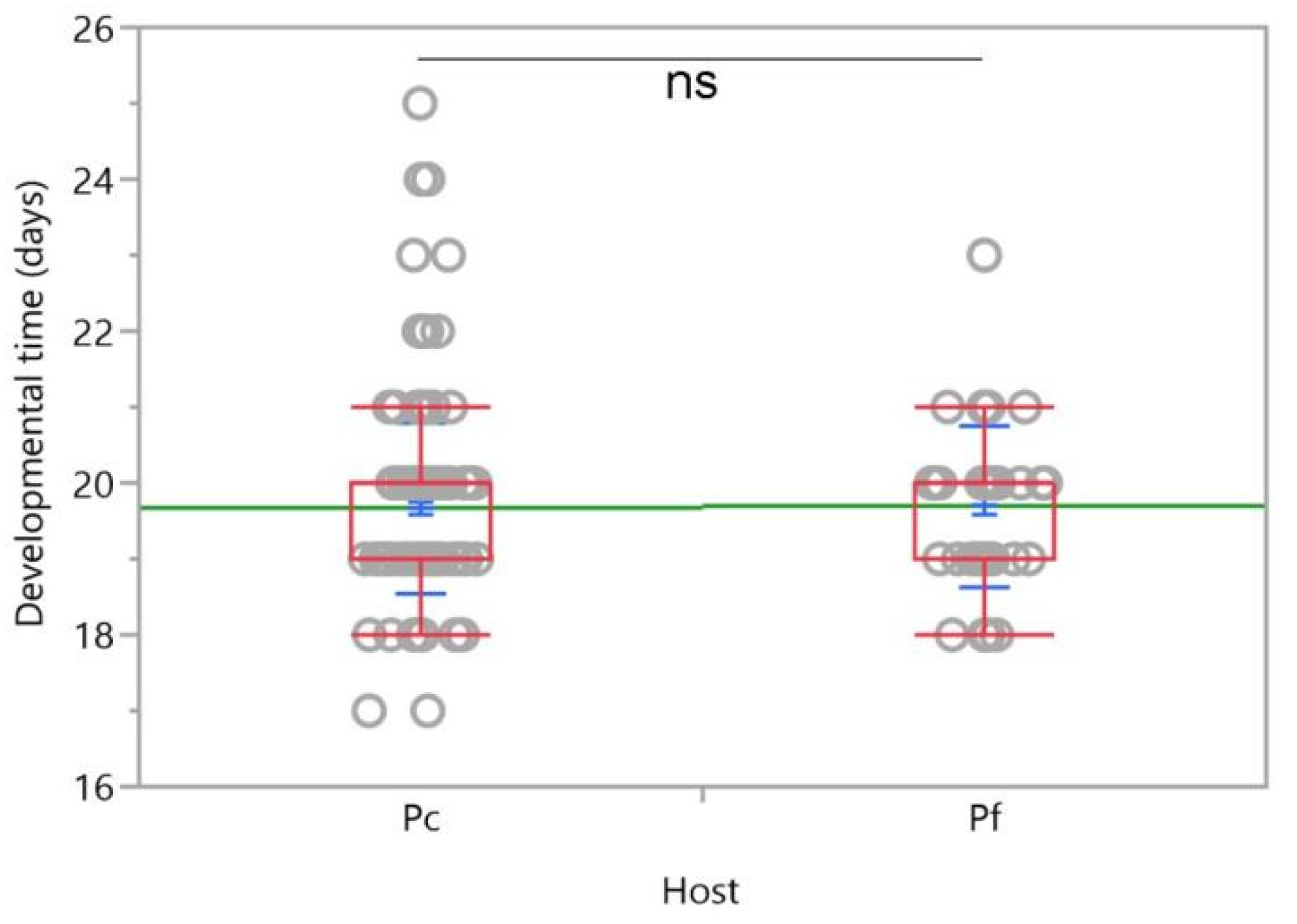
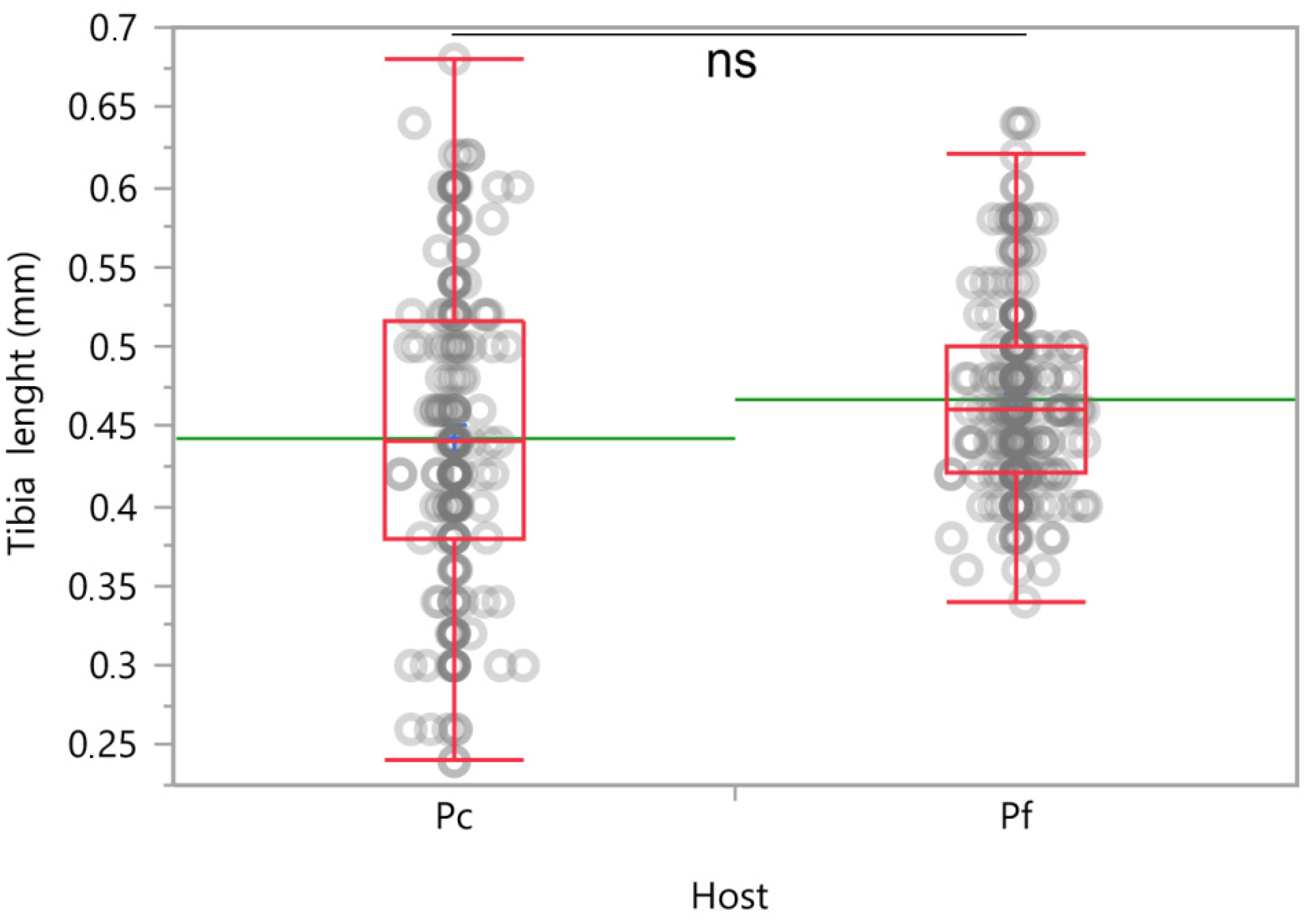

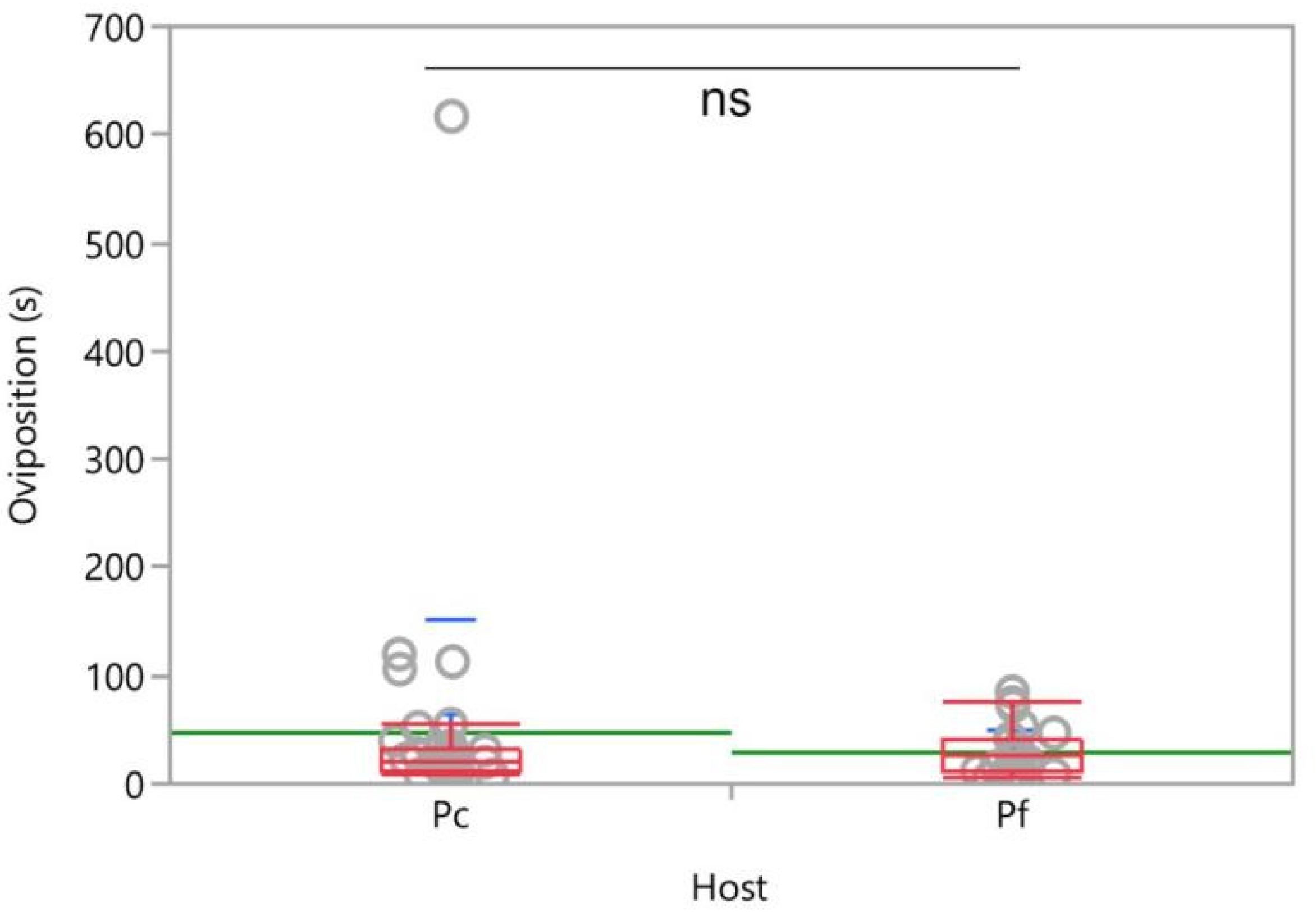
Publisher’s Note: MDPI stays neutral with regard to jurisdictional claims in published maps and institutional affiliations. |
© 2021 by the authors. Licensee MDPI, Basel, Switzerland. This article is an open access article distributed under the terms and conditions of the Creative Commons Attribution (CC BY) license (http://creativecommons.org/licenses/by/4.0/).
Share and Cite
Ricciardi, R.; Zeni, V.; Michelotti, D.; Di Giovanni, F.; Cosci, F.; Canale, A.; Zang, L.-S.; Lucchi, A.; Benelli, G. Old Parasitoids for New Mealybugs: Host Location Behavior and Parasitization Efficacy of Anagyrus vladimiri on Pseudococcus comstocki. Insects 2021, 12, 257. https://doi.org/10.3390/insects12030257
Ricciardi R, Zeni V, Michelotti D, Di Giovanni F, Cosci F, Canale A, Zang L-S, Lucchi A, Benelli G. Old Parasitoids for New Mealybugs: Host Location Behavior and Parasitization Efficacy of Anagyrus vladimiri on Pseudococcus comstocki. Insects. 2021; 12(3):257. https://doi.org/10.3390/insects12030257
Chicago/Turabian StyleRicciardi, Renato, Valeria Zeni, Davide Michelotti, Filippo Di Giovanni, Francesca Cosci, Angelo Canale, Lian-Sheng Zang, Andrea Lucchi, and Giovanni Benelli. 2021. "Old Parasitoids for New Mealybugs: Host Location Behavior and Parasitization Efficacy of Anagyrus vladimiri on Pseudococcus comstocki" Insects 12, no. 3: 257. https://doi.org/10.3390/insects12030257
APA StyleRicciardi, R., Zeni, V., Michelotti, D., Di Giovanni, F., Cosci, F., Canale, A., Zang, L.-S., Lucchi, A., & Benelli, G. (2021). Old Parasitoids for New Mealybugs: Host Location Behavior and Parasitization Efficacy of Anagyrus vladimiri on Pseudococcus comstocki. Insects, 12(3), 257. https://doi.org/10.3390/insects12030257









